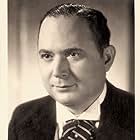Somewhere in the Salzburg mountains, young poacher Hans tries to conquer the heart of pretty schoolteacher Helga but is overthrown by forest warden Thomas. Krambambuli, the dog he once saved... Read allSomewhere in the Salzburg mountains, young poacher Hans tries to conquer the heart of pretty schoolteacher Helga but is overthrown by forest warden Thomas. Krambambuli, the dog he once saved from being drowned, indirectly causes his death.Somewhere in the Salzburg mountains, young poacher Hans tries to conquer the heart of pretty schoolteacher Helga but is overthrown by forest warden Thomas. Krambambuli, the dog he once saved from being drowned, indirectly causes his death.
Photos
C.W. Fernbach
- Gendarmerieinspektor
- (as Franz Fernbach)
Storyline
Did you know
- ConnectionsRemade as Ruf der Wälder (1965)
Featured review
In general in the 1950's the Heimatfilm genre was a kind of escapism for city people who wanted to get away from the problems of every day life and see a world where everything was still pure and simple. In hindsight this nostalgia was a rather innocent pastime, and do we not still see films to get away from everyday life. But there were Heimatfilms that went a step further, and - using a trivial story - accentuated a world with a mentality that was on the verge of the "Blut und Boden" philosophy. These films reflect the hypocritical illusion of a clean world only to be found in the Heimat and in which modern (read: not German/Austrian-traditional) and above all outside influences were to be shut out of.
This film is a good (and I use the word lightly) example of the B&B Heimatfilms and if still not introduced to this typical German/Austrian film genre I can recommend this one: all the clichés and banalities are here, as are a couple of the unavoidable stars of the Heimatfilm genre: the firm-handshake lover Rudolf Prack and Marianne Hold who wore her maidenhead on her forehead. Their emanation is nondescript and as such they are the right choice: not the individual characters are important, but the fitting in of individuals within the community.
The confined space of the Heimat is stressed by the point that not someone from outside the community brings influence from outside, but someone from within the community brings this. He is a man returning to the community after having had a free life outside the community; through this influence he has developed a bad character. And not only that: the community is also invaded by a group of people not knowing a Heimat for themselves at all: traveling fair men and women. Both the returning man and this crowd bring death, despair and anger to the community. The killing of the returning man is not brought about by a community member, but his own dog is indirectly responsible: the man has brought about his own ruin.
Nationalism and traditionalism are of course other items and in this film these are present at a level of suffocating in it. It is accentuated within the story by the president of the folklorist union who claims that the yearly folklorist feast should be held only with the traditional costume being compulsory: costume being the reflection of the someone's inner psychological world. Marianne Hold plays a school teacher whose only job appears to be, and this is simply laughable, to teach the children sentimental, nationalist songs; three times the class is shown and there seems to be nothing else on the curriculum than singing these songs, with the title song Heimatland the most important one: "Heimatland, wie sehn' ich mich nach Dir" (Heimatland, how I long for you). Know your Heimatland first and for all, other things can wait.
Note also that, unlike that other German film genre: the Bergfilm (mountain film), the mountains only play a part as background, as a border to the community. The mountains (= nature) are not there to be conquered; the individual is supposed to be restricted by them, to fit in with nature. The last shots of the film tell it all: the finally married couple on a bench set in the middle of nature: they are a part of nature, of the Heimatland.
It all could have been at least bearable watching if the film was made on an acceptable level. One thing you might expect of a film like this that it can seduce and hypnotise the viewer to let all the banalities be accepted during watching. But the film's director Franz Antel, a regular of the genre, was a clumsy average director without any personality. His direction is plain and without any spirit. All indoor scenes give the impression of being no more than scenes on a stage, which is caused by the plain lightning accentuating everything within the image the same way, and the simplest of cinematography. The conservative political Adenauer credo of the 50's "No experiments" influenced the technique of the conservative Heimatfilm as well.
Not having enough of the original story "Krambambuli", Franz Antel used it again in 1965 for "Ruf der Wälder", a very strange film.
This film is a good (and I use the word lightly) example of the B&B Heimatfilms and if still not introduced to this typical German/Austrian film genre I can recommend this one: all the clichés and banalities are here, as are a couple of the unavoidable stars of the Heimatfilm genre: the firm-handshake lover Rudolf Prack and Marianne Hold who wore her maidenhead on her forehead. Their emanation is nondescript and as such they are the right choice: not the individual characters are important, but the fitting in of individuals within the community.
The confined space of the Heimat is stressed by the point that not someone from outside the community brings influence from outside, but someone from within the community brings this. He is a man returning to the community after having had a free life outside the community; through this influence he has developed a bad character. And not only that: the community is also invaded by a group of people not knowing a Heimat for themselves at all: traveling fair men and women. Both the returning man and this crowd bring death, despair and anger to the community. The killing of the returning man is not brought about by a community member, but his own dog is indirectly responsible: the man has brought about his own ruin.
Nationalism and traditionalism are of course other items and in this film these are present at a level of suffocating in it. It is accentuated within the story by the president of the folklorist union who claims that the yearly folklorist feast should be held only with the traditional costume being compulsory: costume being the reflection of the someone's inner psychological world. Marianne Hold plays a school teacher whose only job appears to be, and this is simply laughable, to teach the children sentimental, nationalist songs; three times the class is shown and there seems to be nothing else on the curriculum than singing these songs, with the title song Heimatland the most important one: "Heimatland, wie sehn' ich mich nach Dir" (Heimatland, how I long for you). Know your Heimatland first and for all, other things can wait.
Note also that, unlike that other German film genre: the Bergfilm (mountain film), the mountains only play a part as background, as a border to the community. The mountains (= nature) are not there to be conquered; the individual is supposed to be restricted by them, to fit in with nature. The last shots of the film tell it all: the finally married couple on a bench set in the middle of nature: they are a part of nature, of the Heimatland.
It all could have been at least bearable watching if the film was made on an acceptable level. One thing you might expect of a film like this that it can seduce and hypnotise the viewer to let all the banalities be accepted during watching. But the film's director Franz Antel, a regular of the genre, was a clumsy average director without any personality. His direction is plain and without any spirit. All indoor scenes give the impression of being no more than scenes on a stage, which is caused by the plain lightning accentuating everything within the image the same way, and the simplest of cinematography. The conservative political Adenauer credo of the 50's "No experiments" influenced the technique of the conservative Heimatfilm as well.
Not having enough of the original story "Krambambuli", Franz Antel used it again in 1965 for "Ruf der Wälder", a very strange film.
Details
- Runtime1 hour 35 minutes
- Color
- Aspect ratio
- 1.33 : 1
Contribute to this page
Suggest an edit or add missing content










